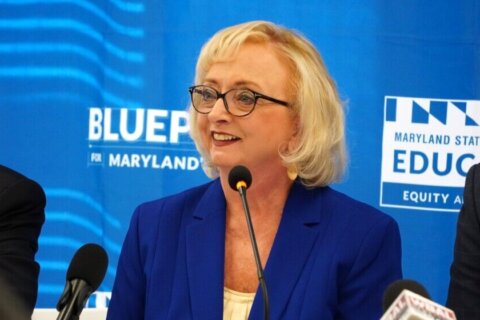Maryland teachers want to include class size in contract negotiations with local boards of education. But currently, that’s illegal in Maryland, and one state senator is working to change that.
“I know I have teachers in my local school who have as many as 40 students in a class,” Democratic state Sen. Pam Beidle, who’s sponsoring the bill, said during a hearing in Annapolis on Thursday. She said, considering those same teachers have four classes of 40 students each, “That’s a lot of children to try to work with and mentor and get to know.”
In a hearing before the Senate Finance Committee in Annapolis, Cheryl Bost, president of the Maryland State Education Association, told lawmakers, “Even before the pandemic, educator retention and recruitment were at crisis levels,” and she said 92% of the MSEA membership wants to be able to discuss class size in collective bargaining.
“This does not call for caps or absolute class size maximums. This piece of legislation just says: Can we talk about possible remedies?” Bost said.
Republican state Sen. Justin Ready asked about other ways to deal with class size, an issue he agreed should be addressed.
“My wife is an elementary school teacher. When you have 30, 27, 28 kids in an elementary school classroom, it’s not the best we can hope for.”
The Maryland Association of Boards of Education opposes the bill. John Woolums, director of governmental relations for MABE, told the panel the fallout from trying to reduce class size would likely put added pressure on school budgets and that many aspects of school funding are “outside our control.”
Schools have three sources of funding — federal, state and local contributions. In Montgomery County, for example, roughly 64% of the budget comes from the county’s contribution, another 28% comes from the state.
During Thursday’s hearing before the Senate Finance Committee, the possible impact of the state’s “Blueprint for Maryland’s Future,” an education reform plan, came up several times.
Mary Pat Fannon, executive director of the Public School Superintendent’s Association of Maryland, said there are “so many moving parts” in the blueprint that it’s like a game of “Whack-A-Mole,” where a change in one area of budgeting would impact another.
Fannon also said that allowing class size to be part of collective bargaining could result in labor agreements that could worsen inequities — with wide variations in class size across the state.
Students and one teacher from Baltimore testified in favor of the bill.
“It wasn’t two years ago when I had 67 students on my summer school Spanish class roster — 67 students!” said Nathan Ferrell, a Baltimore City public school Spanish teacher speaking on behalf of the Baltimore Teacher’s Union.” Class size has effects on student achievement, student participation and the overall student experience in school.”
Camila Calero, a Baltimore City College High School student who takes part in an after-school program called ¡Adelante Latina!, said the small class size in that program allows her to flourish.
“I am able to ask my teachers questions without fearing that I’m taking up too much time, or that my classmates will judge me. I’m able to get help with one-on-one conversations,” she said.








